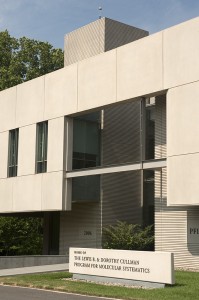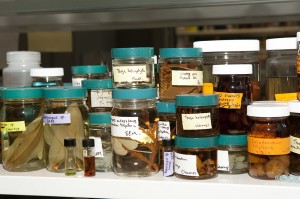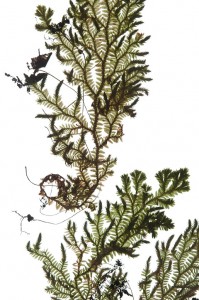Science Open House Redux: November 12 – 13
Posted in Programs and Events, Science on September 30 2011, by Ann Rafalko
Saturday and Sunday, November 12-13, 2011

Our last attempt at hosting this “inside look” at The New York Botanical Garden‘s Science campus was rained out by a certain tropical storm (we’re looking at you Irene), so we’re trying again. And this time we’re making it even bigger and better than before!
The Science Open House weekend will be held in conjunction with the second Thain Family Forest Dedication festival weekend, which means there will be a ton of fun activities for the whole family! Start inside with a look at the beautiful Pfizer Plant Research Laboratory, then explore the fascinating William and Lynda Steere Herbarium, and finally, listen to Garden scientists talk about their forest-based research. Then head outside and enjoy the beauties of fall in the Garden’s historic, 50-acre Thain Family Forest: take an expert-led nature walk, canoe down the Bronx River and learn about its wildlife, climb a tree with an arborist, and so much more. The Garden is never the same two days in a row, so come spend a day in one of the world’s greatest urban gardens, The New York Botanical Garden!

This weekend-long event will offer the public a rare insider’s view of The New York Botanical Garden’s Science campus.
Garden scientists will lead tours of the Pfizer Plant Research Laboratory and William and Lynda Steere Herbarium.
Briefings from the Field, a short lecture series will feature updates from the fieldwork of various Garden scientists on Saturday at 2 p.m. in the Ross Hall
Garden scientists are working all over the world on plant-related studies ranging from working to preserve the endangered flora of Puerto Rico, to searching for lichens and mosses at the ends of the earth, to hunting for hidden pathogens in North America’s cranberry bogs, and to empowering junior high school girls through flowers. Come visit these beautiful and fascinating facilities (get a preview of the Pfizer Lab here) and hear the stories of discovery from the Garden’s scientists themselves.
Science Open House Weekend Schedule
Tours – Saturday, November 12 and Sunday, November 13
All tours will meet at the Ross Gallery. Each tour capacity will be a maximum of 25 people and is on a first-come, first-served basis. No reservations will be accepted. Tours will be led by Garden scientists.

12 p.m.
Tour of the Pfizer Lab, home of the Lewis B. and Dorothy Cullman Program for Molecular Systematics
Tour of the William and Lynda Steere Herbarium
1 p.m.
Tour of the Pfizer Lab, home of the Lewis B. and Dorothy Cullman Program for Molecular Systematics
Tour of the William and Lynda Steere Herbarium
Lecture – Saturday, November 12 Only
2 p.m. in the Ross Hall
Briefings from the Field: A short lecture series by Garden Scientists
Hear first hand from the scientists who work at the Garden and in forests around the world about what it is like to work outside of a traditional office.
Robert Naczi, Ph.D., Botanical Change in our Backyard: Recent Trends in the Vegetation of the Northeastern U.S. and Adjacent Canada
Paola Pedraza, Ph.D., Diversity and Conservation of Andean Forests: Searching for Blueberries
James Miller, Ph.D., Research to Inform Conservation: Assessing Risk of Extinction for the World’s Plant Species
Why Science?
The New York Botanical Garden is one of the world’s preeminent freestanding plant research organizations. The Garden conducts basic research in plant biology and studies all species of plants and fungi around the globe. Our scientists use sophisticated techniques such as molecular systematics, genomics research, and digital imaging. Never before has the need been greater to integrate the use of our unparalleled resources–in the field, laboratory, library, and herbarium–to maximize the impact of our work and maintain our position at the forefront of worldwide botanical research.
With its longstanding scientific mission and unmatched facilities, the Garden is uniquely positioned to address increasing environmental challenges. The William and Lynda Steere Herbarium collection, assembled by our scientist explorers over more than a century, is among the four largest in the world and the largest in the Western Hemisphere; the C.V. Starr Virtual Herbarium database adds 45,000 new records each year; the LuEsther T. Mertz Library is the world’s most important botanical and horticultural resource of its kind; our internationally renowned scientific staff work in the state-of-the-art Pfizer Plant Research Laboratory and a pioneering Lewis B. and Dorothy Cullman Program for Molecular Systematics, while running the largest botanical sciences Graduate Studies Program at any botanical garden in the world.
The Garden brings remarkable assets to the scientific enterprise. Its physical and human resources together comprise one of the top science, research, education, and scholarly centers in the world, distinguished in scope, depth, authority, and excellence. The Garden’s greatest distinction, however, lies in the way its many assets are interwoven to form an entity greater than the sum of its parts. From remote field sites to state-of-the-art laboratories, Garden scientists are working in concert to study and preserve the world’s botanical heritage—and to help ensure the future of life on Earth.


May I please reserve a place for me at both the Saturday November 12 noon and 1 p.m. tours, and the 2:00 lecture. Thank you.